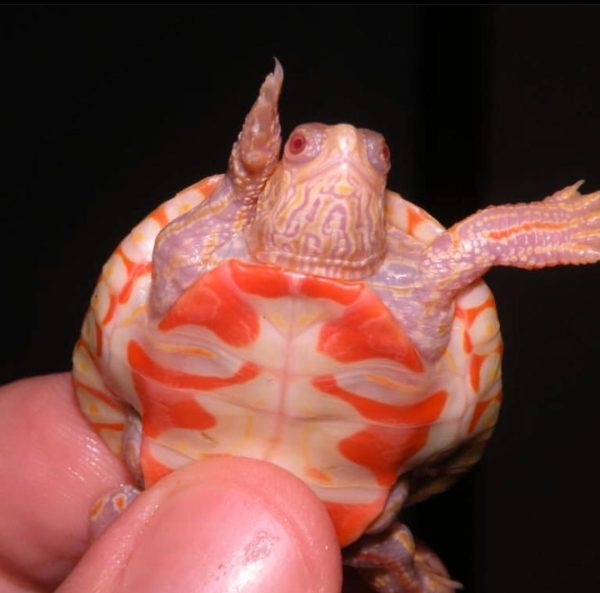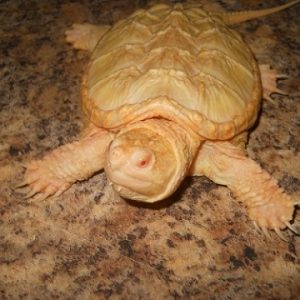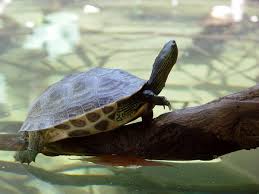Western Painted
| Western Painted A small turtle with red markings on the marginals and a smooth, oval, somewhat flattened keelless carapace which is black, brown, or olive in color with a network of faint light lines and olive, yellowish, or red borders along front edge of the shields. The posterior rim of the carapace has a smooth (not serrated) border. The limbs and head are black to olive and marked with yellow lines. Yellow stripes extend rearward from underneath the eyes and often from below the jaw. The upper jaw is notched in front. The unhinged plastron is reddish with a large dark mark in the center which branches out between the scutes. |
| Male / Female Differences |
| Males are smaller than females and have very long nails on the front feet. A male’s plastron is more concave toward the rear than it is on a female. |
| Young |
| The plastron coloring on juveniles is more strongly contrasted than on adults. |
| Similar Species |
| Turtles of another alien species – Red-eared Slider, Tracemys scripta elegans, are more common in California waters than painted turtles. You can use a couple of details to tell them apart in the field if you can get close enough, the color behind the eye and the rear of the shell. See above. If you get the turtle in hand, you can also look at the plastron, which will be marked with a lot of red on the painted turtle but not marked with red on the slider. |
| Life History and Behavior |
Activity |
| Aquatic and diurnal. Sleeps at night on the bottom or on a partially submerged object. Probably active all year long in the south but inactive during cold periods. In the north, probably hibernates beginning in late fall, emerging in March or April. Often seen basking on rocks, logs, or dirt banks, sometimes in large groups. Relatively cold-tolerant. In some areas, they can be observed swimming under ice just before it melts in March. |
| Turtles Walking on Land Do Not Always Need to be Picked Up and Rescued |
| Turtles sometimes leave the water to search for food, a better place to live, a mate, or to lay their eggs in the spring – typically from March to June. If you see a turtle walking on the land, it is probably not sick or lost, so the best thing you can do for the turtle is to leave it alone. Some people want to help a turtle they think is in danger by picking it up and bringing it home or to a wildlife rehabilitation center, but most of the time this harms the turtle by removing it from the wild without reason. Sometimes turtles do get lost or stranded in yards or on busy roads or somewhere where they may be in danger. If you find one in such a situation, it’s ok to move it out of danger, but it’s best to leave it in a safe place as close to where you found it as possible. |
| Diet and Feeding |
| An omnivorous generalist – eating almost anything found in its habitat, including insects, worms, snails, crayfish, fish, amphibians and tadpoles, carrion, and aquatic vegetation. Young are carnivorous, but become more herbivorous as they grow older. |
| Reproduction |
Z |
| Habitat |
| Ponds, marshes, lakes, ditches, quiet streams with sandy or muddy bottoms and aquatic vegetation. |
Geographical Range |
| Chrysemys picta – Painted Turtle – is the most widespread species of freshwater turtle inhabiting North America, ranging across the entire continent from southeastern Canada to Louisiana to Washington, with isolated populations in Utah, Arizona, New Mexico and Texas.
The species is reported to be introduced and established in waters throughout populated areas of coastal southern California, however I can find very few sight records or museum specimens for this species from anywhere in California. It is likely that most of the sightings of this species did not result in specimens being collected and deposited in a museum or written up as a sight record in a herpetological journal. It’s also possible that some turtles identified at a distance as painted turtles might be Red-eared Sliders since they are similar in appearance at a distance. My range map shows the same general range in the heavily-population region of coastal southern California that is found in most field guides, including Stebbins and McGinnis, 2012, even though I cannot find very many records from this area. It makes sense that they are found in the area, although not in every pond and lake. I suspect that the species can be found in other locations throughout the state where pet owners have dumped them, but it is uncertain if they have been established in many of those locations. (There are also reports of this species from Napa and Solano Counties, with no specific locations given.) I’ve also seen pictures of an Eastern Painted Turtle – C. p. picta, that was found on the Stanislaus River below Knights Ferry.
In the late 1970s, some painted turtles were released at Kaiser Meadow in Siskiyou County. A local science teacher notified Robert Stebbins resulting in the inclusion of the location in his subsequent field guides (including his final 2013 guide). Searches there since the 1980s have uncovered no painted turtles, only native pond turtles. It appears that there is no established population at Kaiser Meadow, so I have left that location off my range map. (James Buskirk, pers. comm.) |






Reviews
There are no reviews yet.